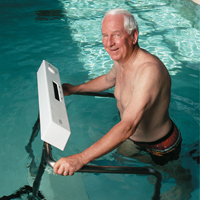Wouldn’t it be great if you could stay strong, flexible and fit with a low-risk exercise program and have some fun at the same time? The solution could be as close as your nearest swimming pool. Swimming is a great exercise for people with hemophilia and other bleeding disorders.
Water’s natural properties dramatically lower the risk of stress-related injuries. Working out in the water is a great way to build strength, agility and endurance without taxing your joints, muscles and bones. And you do not have to know how to swim in order to benefit from aquatic exercise. All you need is a comfortable swimsuit or trunks and maybe some water shoes.
There are two main routes to the pool to consider: physical therapy and community pool programs. The first approach, which many people take to get started, is a prescription from their physician for customized physical therapy from a qualified provider. Grace Volsen, MPT, ATRIC, an aquatic therapist at Sacred Heart Medical Center and Children’s Hospital in Spokane, Washington, describes aquatic therapy as “a great way to get moving again.”
[Steps for Living: Maintaining a Healthy Body]
“The pool is a fantastic environment to start rehabilitation for all ages,” she says. “We do a lot of work with children who are having trouble with early joint bleeds. It also improves the quality of life for folks that are a little older who have trouble walking due to ankle, joint or knee bleeds; they can successfully work on range of motion, strengthening and walking in the water.”
Volsen works toward “transitioning” her patients to the community pool programs. “I find that if people can be compliant with their physical therapy program, they can transition to a community-based aquatic program where they continue independently. It’s great for not only their physical mobility, but for their mental well-being. It’s also a great place to work on cardiovascular fitness.”
Either way, of course, you’ll need a thorough checkup from treating physicians or an HTC that updates your current fitness level, bleeding history and joint status. Many pool programs require a note from a doctor indicating that an applicant is able to participate in a water-exercise program.
Why Swimming is So Great for People With Hemophilia
Although many people find aquatic therapy to be tremendous fun, it is also a serious subject of medical studies. Brenda Buzzard, superintendent physiotherapist at the Newcastle upon Tyne regional hemophilia center in the United Kingdom, is internationally known in the area of water therapy. She has published several articles on the topic in peer-reviewed medical journals.
 Buzzard says she teaches her patients a series of exercises to prevent muscle wasting, improve joint range and strengthen muscles. Exercise in water for the bleeding disorders community is one of her favorite subjects because, she says, it works. “People with hemophilia can achieve a healthy lifestyle by maintaining their levels of treatment and body weight—obesity is one of the bigger problems we’re facing now,” she says.
Buzzard says she teaches her patients a series of exercises to prevent muscle wasting, improve joint range and strengthen muscles. Exercise in water for the bleeding disorders community is one of her favorite subjects because, she says, it works. “People with hemophilia can achieve a healthy lifestyle by maintaining their levels of treatment and body weight—obesity is one of the bigger problems we’re facing now,” she says.
[Steps for Living: Healthy Eating and Healthy Body Weight]
Light swimming is one of the best holistic exercises for the joints and the muscles around them, says Buzzard. “The increased density of water creates even and fluid resistance, comfortably toning and strengthening the body with greater balance and efficiency,” she says. “The accommodating resistance of water allows patients to exercise at their own pace, while the refreshing nature of water provides a soothing distraction from pain and stress.”
A good place to begin a search for a quality pool program is the local university medical center. Sandra Stefanuto is a physical therapist and wellness center coordinator at the University of California San Francisco (UCSF) Medical Center. She’s been a physical therapist for more than 30 years and a pool therapist for about two years. She has seen many conditions improve. “What we’re doing here is not standard physical therapy (PT) that requires a doctor’s prescription,” Stefanuto says. “We’re seeing people after their PT has finished.”
New members of the exercise group receive a personal evaluation before they get into the pool, and careful notes are kept on their conditions and progress. “We like to know what is normal for each person, so we don’t ask them to go too far when they’re doing their exercises,” Stefanuto says.
A typical session begins with taking a thorough health history. Certain conditions will necessitate a doctor’s approval form. A brief screening is then conducted to detect particular problems or areas of concern, especially if the range of motion has been limited in joints. All exercises are recommended according to each person’s ability and goals. Stefanuto says she spends her days in the pool with clients, testing their balance and abilities and giving extra help while they’re doing activities. Costs can vary according to services and geographic areas.
Volsen emphasizes the enjoyment of being in the water. “Let’s not forget the fun,” she says. “Most everyone can benefit from aquatic therapy, especially a person with a chronic illness who is in chronic pain.”
[Steps for Living: The Pain Facts]

